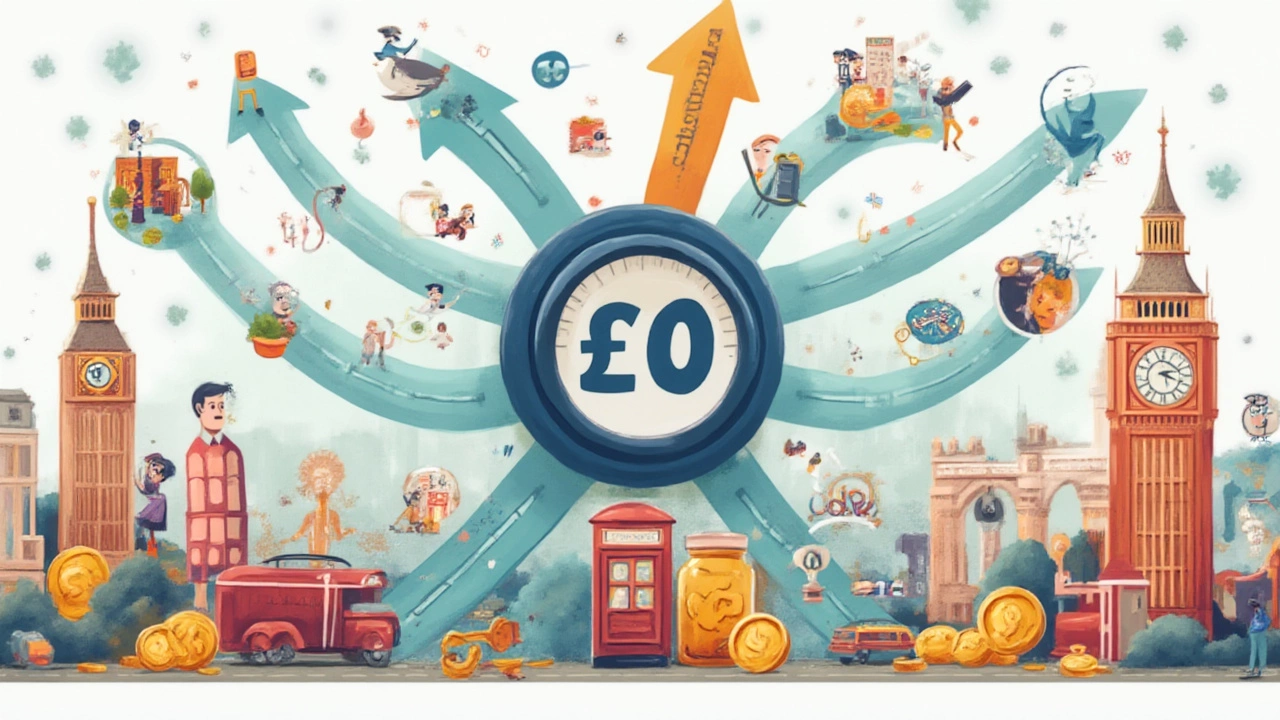Ever feel like your paycheck just sort of... disappears? That's not as strange as it seems; tons of people lose track of where their money goes each month, especially when life gets busy. But here’s the kicker—a method from the 1970s still helps people boss their budgets in 2025, and it’s called zero-based budgeting. This is not just about trimming a latte here or skipping a splurge day there. It’s about giving every single dollar you earn a job—on purpose. If that sounds a bit intense, you’re on the right track. Zero-based budgeting goes way deeper than tossing numbers into categories or using those stick-to-what-you-spent-last-month budget apps. It's a system built to turn chaos into clarity, for anyone sick of being shocked by their bank statement.
What Is Zero-Based Budgeting?
Zero-based budgeting (often called ZBB for short) isn’t new, but it sure feels like a game-changer every time you use it right. The big difference between this method and a traditional budget is that every month, you start from zero. No rolling over old categories. No copy-pasting last month’s budget because you’re in a rush. You take your income and assign every dollar a purpose—savings, bills, spending, whatever—until you hit exactly zero. It’s not about spending every dollar, but about accounting for it. This method popped up in big companies back in the 1970s—thanks to Texas Instruments, of all places—when managers wanted to justify every expense, not just build automatically on top of what the company spent last year. That same approach works wonders for your paycheck, too. It can sound strict, but it actually gives you more freedom since you know exactly what you can afford—guilt-free—without crossing your fingers at the checkout.
There’s an interesting stat from the 2023 FINRA National Financial Capability Study: barely a third of Americans keep a detailed household budget. The rest? They go with the flow and hope nothing floods their account. Zero-based budgeting ensures nothing sneaks past you. Every category gets a fresh look monthly, which is perfect for freelancers with irregular earnings, families juggling changing expenses, or just about anyone tired of feeling left out after payday.
How Does Zero-Based Budgeting Actually Work?
If zero-based budgeting feels a little alien, it’s just because we’re so used to leftovers—leftover money, leftover plans, leftover worries about what we missed. Here’s how ZBB flips that upside down:
- List your income: Write down your take-home pay for the month. Don’t guess. If your pay varies, estimate low (better safe than bank fees!).
- Identify your priorities: List everything you need money for—fixed bills (rent, utilities), savings goals, groceries, a little fun. Be real about it—hide nothing.
- Assign every dollar to a job: Start with the essentials and keep assigning each dollar you expect to earn. If something isn’t covered, it doesn’t make the cut this month. If you find you’re in surplus, give that money a mission—stash it in savings or use it to crush a debt.
- Adjust as life happens: Nobody’s month is ever truly “ordinary.” Your budget will change if you get sick, get a bonus, or just get tempted by that “limited-time offer” in your inbox. Move money between categories, but always make sure every dollar still has a job. That’s the rule.
- Track and review: Your budget works if you actually check it. Use an app, spreadsheet, or the old-fashioned notebook—whatever helps you see your plan versus reality each week.
A huge myth is that zero-based budgeting kills your social life or hobbies. It’s the opposite. By knowing your limits, you say “yes” to fun plans without guilt, and you’ll feel way lighter. You might even find hidden habits (like sneaky app subscriptions or eating out because the fridge is empty) that have been costing you way more than you’d guessed. A 2024 study by You Need a Budget users saw that, on average, people wasted an extra $260 on unplanned ‘micro-purchases’ before trying ZBB; that’s hundreds each year back in your pocket once you zero in on the leaks.
Worried About Tracking Your Spending? Try These Tips
Sure, when you hear “every dollar needs a job,” it can sound as tedious as cleaning under the fridge. But real talk—zero-based budgeting doesn’t have to eat up your time. Apps like YNAB, EveryDollar, and Goodbudget do most of the math for you, but you can crush it with a notebook and a habit, too. Here are some ideas that actually work (not just the “skip your morning coffee” stuff):
- Make it a 5-minute ritual: Each night, jot down what you spent that day. Miss a day? No shame—catch up the next morning. The act of looking keeps splurges in check.
- Set a ‘fun money’ category: Go wild, but only with what’s budgeted. This gives you a break from the grind and keeps FOMO (fear of missing out) at bay.
- Use visual cues: Color-code or even use stickers in your planner to track categories. It sounds a bit “back to school” but makes the numbers less scary and more fun.
- Automate the big stuff: Have bills and some savings transfer on payday—one less thing to track manually. This means your essentials are always covered, and you only handle the flexible stuff.
- Celebrate small wins: Paid off a credit card or stuck to your takeout budget for once? Treat yourself, even if it’s just sharing your progress with a friend or on social media. Positive reinforcement changes habits much faster.
Most people drop their budgets because tracking gets exhausting. If you miss a week, don’t quit. Just start with today’s money. According to a 2022 Harris Poll, folks who “forgave themselves” for small mess-ups were way more likely to stick with a budgeting system—ZBB or otherwise—for a whole year. The system is flexible. Your mindset has to be, too.
Zero-Based Budgeting vs. Other Budget Systems
Before you dive all in, it’s fair to wonder: Why not just stick with the classic envelope system or a 50/30/20 rule? Each style has its fans, but here’s how zero-based budgeting really stacks up:
- Envelope Budgeting: Classic cash-in-envelopes for categories. The problem? Cash is disappearing, and people hate carrying it around. ZBB works whether you’re team cash, debit, or even Apple Pay.
- 50/30/20 Rule: This splits your paycheck into 50% needs, 30% wants, 20% savings/debt. Simple, but what if your ‘needs’ are 60% of your income? ZBB lets you work with what’s actually on your plate each month, not a broad rule.
- Traditional Budgets: “Last month we spent $200 on groceries, so let’s stick to that.” It feels safe but ignores surprise costs or savings opportunities. ZBB forces you to rethink—not just repeat—the same budget endlessly.
One fact from the Bureau of Labor Statistics: Monthly household spending changes by up to 22% depending on season, family events, or unexpected bills. That means rigid budgets often miss the mark. Zero-based budgeting is built to ebb and flow—perfect for real life, not just spreadsheet life. It works for those pesky annual costs, too—like car insurance or vet visits—by letting you sock away a bit each month for big, not-so-fun expenses down the road.
If you like knowing you’re squeezing the most value from your cash each month, ZBB is hard to beat. It’s a more hands-on experience, but so are the best rewards.

Real-Life Results: Data and Stories from Zero-Based Budgeters
A budgeting method is only as good as the peace of mind it brings, right? Let’s look at how zero-based budgeting shakes out in the wild, with numbers and real stories, not just theory.
| Benefit | Percentage of ZBB Users Reporting |
|---|---|
| Lower monthly overspending | 67% |
| Better saving habits | 59% |
| Less money-related stress | 53% |
| Reached emergency fund goal | 48% |
| Paid down debt faster | 62% |
Take Sara, a teacher in Ohio, who went from dreading bill days to looking forward to them. She set up a zero-based budget after getting hit with two surprise car repairs in a row. Instead of guessing if she could swing repairs next time, she started funneling $80 a month into a car fund. Her story is pretty typical: after sticking to ZBB for six months, she paid off a lingering credit card, dialed back her impulse buys, and admitted she actually had fun because her “fun” category was built in, not an afterthought.
Another story, from Raj, a freelance graphic designer in Toronto, hits home for irregular income earners. His work was feast-or-famine, and the traditional budget always left him crossing his fingers for next month. Once he started zero-based budgeting, he set a baseline “survival” budget for skinny months and funneled overflow to bulk up slow months. He stopped dipping into savings just because the month hit a slow patch. Real numbers tell the same story: a 2023 Simple Dollar survey found ZBB users lowered “surprise” overdrafts by up to 70% in their first year.
The best part? You don’t need to live on rice and beans or ditch the occasional splurge. You just stop feeling guilty about it. Awareness changes everything—when you see exactly how much money you’re working with, you make better decisions effortlessly. Want to try it? Just grab a pen, open your bank app, and give every dollar a mission. Your future self (probably less stressed and more in control) will thank you.
